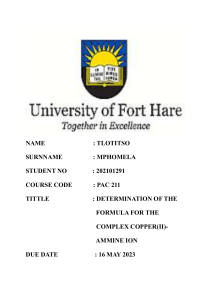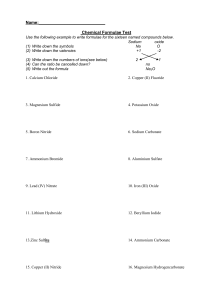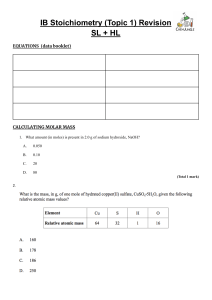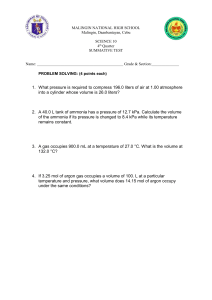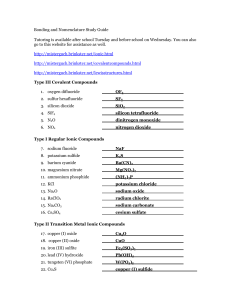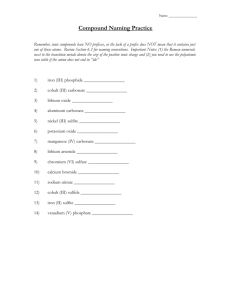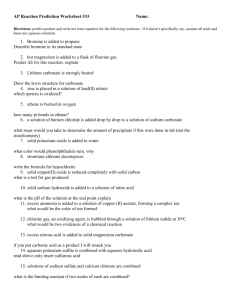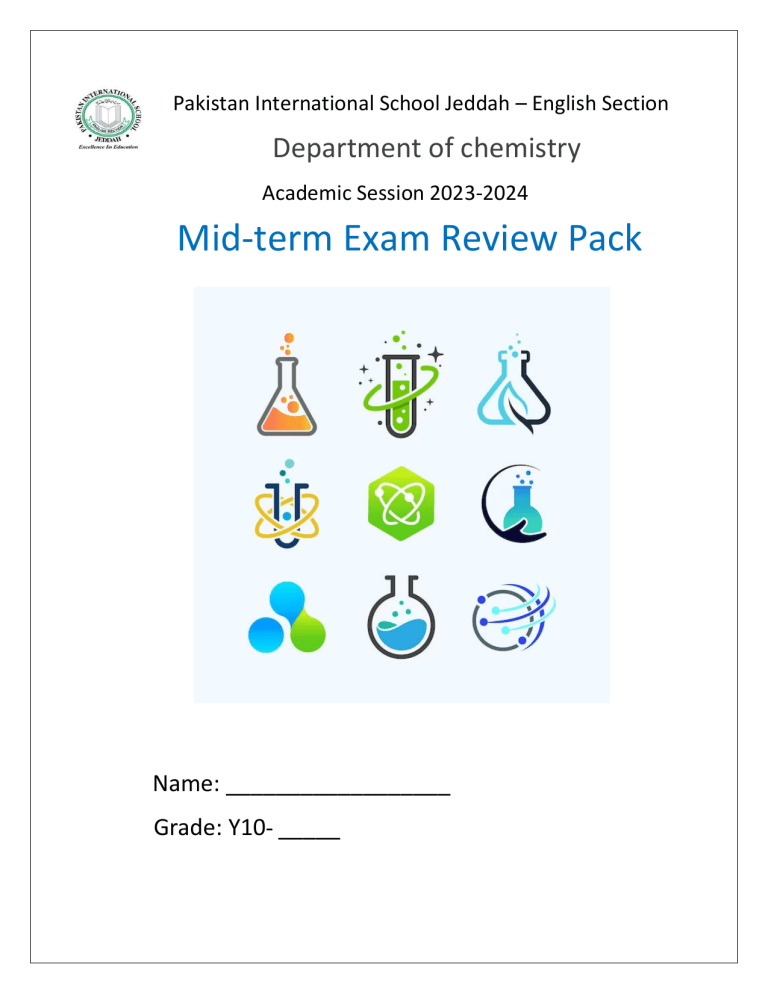
Pakistan International School Jeddah – English Section Department of chemistry Academic Session 2023-2024 Mid-term Exam Review Pack Name: __________________ Grade: Y10- _____ 1. substance melting point / °C boiling point / °C electrical conductivity as a solid electrical conductivity as a liquid A 839 1484 good good B –188 –42 poor poor C 776 1497 poor good 117 78 poor poor E 1607 2227 poor poor F –5 102 poor good D – (a) Which substance could be a metal? [1] (b) State all the substances that are liquid at room temperature. [1] (c) Which substance could have a macromolecular structure similar to that of silicon(IV) oxide? [1] (d) Which substance could be sodium chloride? [1] [Total: 4] 1 2. [Total: 8] (b) The diagrams represent the same number of particles of a gas in two containers, D and E, which have different volumes. The two containers are at the same temperature. D E In which container will the pressure be higher? Explain your answer. .................................................................................................................................................... .................................................................................................................................................... .............................................................................................................................................. [1] 3. Complete the following table which gives the number of protons, electrons and neutrons in each of the five particles. particle .............. 56 26 Fe .............. 3+ 70 31 Ga .............. number of protons number of electrons number of neutrons 19 19 20 .............. .............. .............. 3 2 4 .............. .............. .............. 34 36 45 [Total: 8] 4. (a) b. c. Magnesium reacts with chlorine to form magnesium chloride, MgCl 2. One physical property typical of ionic compounds, such as MgCl 2 , is that they are soluble in water. Give two other physical properties that are typical of ionic compounds. 1 ........................................................................................................................................ 2 ........................................................................................................................................ [2] d. Aqueous silver nitrate is added to aqueous magnesium chloride. A white precipitate forms. Write an ionic equation for this reaction. Include state symbols. .............................................................................................................................................. [2] 5 (a) (b) 6 (a) Aqueous ammonium sulfate, (NH4 )2SO4, is warmed with aqueous sodium hydroxide. The pungent-smelling gas ammonia, NH3, is produced. Balance the equation for this reaction. (NH4) 2SO4 + ......NaOH → ......NH3 + ......H2O + Na2SO4 [1] (b) A 2.8 g sample of impure ammonium sulfate is found to contain 0.7 g of impurities. Calculate the percentage of ammonium sulfate in this sample. percentage of ammonium sulfate = .............................. % [1] 2 (c) Ammonia gas is prepared at the front of a laboratory. The pungent smell of ammonia spreads throughout the laboratory slowly. (i) Name the process that occurs when ammonia gas spreads throughout the laboratory. .................................................................................... ................................................... (ii) [1] Explain, using ideas about particles, why ammonia gas spreads throughout the laboratory. ............................................................................................................................................. ............................................................................................................................................. ............................................................................................................................................. ....................................................................................................................................... [2] (iii) Explain why carbon dioxide gas, CO2 , will spread throughout the laboratory at a slower rate than ammonia gas, NH3. ............................................................................................................................................. ....................................................................................................................................... [1] (d) Ammonia is produced in the Haber process. The equation for the reaction is shown. N2(g) + 3H 2(g) → 2NH3 (g) (i) In the Haber process, a temperature of 450 °C and a pressure of 200 atmospheres are used in the presence of finely‑divided iron. A larger equilibrium yield of ammonia would be produced if a lower temperature and a higher pressure are used. Explain why a lower temperature and a higher pressure are not used. lower temperature ............................................................................................................... ............................................................................................................................................. higher pressure ................................................................................................................... ............................................................................................................................................. [2] (ii) Suggest the pH of aqueous ammonia. ....................................................................................................................................... [1] 3 7 (a) Nitrogen reacts with fluorine to form nitrogen trifluoride, NF3. (i) The chemical equation can be represented as shown. N≡N + 3 F–F 2 F–N–F F Some bond energies are shown in the table. bond bond energy in kJ / mol N≡N 945 F–F 160 N–F 300 Calculate the energy change for the reaction between nitrogen and fluorine, using the following steps: ● energy taken in to break bonds .............................. kJ ● energy released when bonds are formed .............................. kJ ● energy change during the reaction. .............................. kJ / mol [3] (ii) Use your answer to (i) to deduce whether this reaction is endothermic or exothermic. Explain your answer. ............................................................................................................................................. ....................................................................................................................................... [1] 4 (iii) Complete the dot-and-cross diagram to show the electron arrangement in a molecule of NF3. Use dots for nitrogen electrons and crosses for fluorine electrons. Show outer electrons only. F N F F [3] (b) Lithium nitride melts at 813 °C. Nitrogen trifluoride melts at –206 °C. Explain in terms of attractive forces why lithium nitride has a much higher melting point than nitrogen trifluoride. In your answer refer to the types of attractive forces between particles and their relative strengths. .................................................................................................................................................... .................................................................................................................................................... .................................................................................................................................................... .............................................................................................................................................. [3] 5 8. (vi) Write the ionic half-equation for the formation of aluminium during the electrolysis. ................................................................................................................................................... 6 [1] . 9 (i) 10. Three ways of making salts are ● ● ● titration using a soluble base or carbonate neutralisation using an insoluble base or carbonate precipitation. (a) Complete the following table of salt preparations. method titration reagent 1 reagent 2 ................................... ................................... salt sodium nitrate ................................... ................................... neutralisation nitric acid ................................... copper(II) nitrate ................................... precipitation ................................... ................................... silver(I) chloride ................................... ................................... neutralisation sulfuric acid zinc(II) carbonate ................................... ................................... [6] (b) (i) Write an ionic equation with state symbols for the preparation of silver(I) chloride. .............................................................................................................................. [2] (ii) Complete the following equation. ZnCO3 + H2SO4 → ............... + ............... + ............... [2] [Total: 10] 8 11. Copper(II) oxide reacts with dilute hydrochloric acid. CuO(s) + 2HCl (aq) CuCl 2(aq) + H 2O(l) 6.00 g of copper( II) oxide were added to 50.0 cm3 of 1.00 mol / dm3 hydrochloric acid. This was an excess of copper(II) oxide. (a) (i) Calculate the number of moles of copper(II) oxide added to the hydrochloric acid. moles of copper(II) oxide = ............................. mol [2] (ii) Calculate the number of moles of hydrochloric acid used. moles of hydrochloric acid = ............................. mol [1] (iii) Calculate the mass of copper(II) oxide that did not react. mass of copper(II) oxide that did not react = ............................. g [2] (b) Crystals of hydrated copper(II) chloride were obtained from the solution at the end of the reaction. The crystals had the following composition by mass: Cl, 41.52%; Cu, 37.43%; H, 2.34%; O, 18.71%. Calculate the empirical formula of the crystals. empirical formula = ............................. [2] 10 12. (a) When aqueous sodium hydroxide is added to aqueous iron(II) sulfate, a precipitate forms. (i) What colour is this precipitate? ....................................................................................................................................... [1] (ii) Write the ionic equation for this reaction. Include state symbols. ....................................................................................................................................... [3] .................................................................................... ................................................... (b) (c) Deduce the charge on the iron ion in each of these compounds. FeF3 ........................................................................................................................................... Fe(NO3) 3 .................................................................................................................................... [2] 11 13. 13 14. At most temperatures, samples of nitrogen dioxide are equilibrium mixtures. 2NO2 (g) dark brown N2O 4(g) pale yellow (i) At 25 °C, the mixture contains 20 % of nitrogen dioxide. At 100 °C this has risen to 90 %. Is the forward reaction exothermic or endothermic? Give a reason for your choice. .................................................................................................................................... .................................................................................................................................... .............................................................................................................................. [2] (ii) Explain why the colour of the equilibrium mixture becomes lighter when the pressure on the mixture is increased. .................................................................................................................................... .................................................................................................................................... .............................................................................................................................. [2] 14 15. Ammonia is a compound which only contains the elements nitrogen and hydrogen. It is a weak base. (a) (i) Define the term base. .............................................................................................................................. [1] (ii) Given aqueous solutions of ammonia and sodium hydroxide, both having a concentration of 0.1 mol / dm 3, how could you show that ammonia is the weaker base? .................................................................................................................................... .................................................................................................................................... .............................................................................................................................. [2] (b) The position of tin in the reactivity series is: zinc iron tin copper For each of the following, decide if a reaction would occur. If there is a reaction, complete the equation, otherwise write ‘no reaction’. Cu + Sn2+ → .......................................... Fe + Sn2+ → .......................................... Sn + Zn2+ → .......................................... 15 [4] 16. 20.0 g of small lumps of calcium carbonate and 40 cm3 of hydrochloric acid, concentration 2.0 mol / dm3 , were placed in a flask on a top pan balance. The mass of the fl ask and contents was recorded every minute. . cotton wool to prevent drops of acid spray escaping flask 40 cm3 of hydrochloric acid, 2.0 mol / dm3 20.0 g of small lumps of calcium carbonate balance The mass of carbon dioxide given off was plotted against time. mass of carbon dioxide 0 0 time CaCO3(s) + 2HCl (aq) CaCl 2(aq) + H2O(l) + CO2(g) In all the experiments mentioned in this question, the calcium carbonate was in excess. (a) (i) Explain how you could determine the mass of carbon dioxide given off in the first five minutes. .............................................................................................................................. [1] (ii) Label the graph F where the reaction rate is the fastest, S where it is slowing down and 0 where the rate is zero. [2] (iii) Explain how the shape of the graph shows where the rate is fastest, where it is slowing down and where the rate is zero. .................................................................................................................................... .................................................................................................................................... .............................................................................................................................. [2] (b) Sketch on the same graph, the line which would have been obtained if 20.0 g of small lumps of calcium carbonate and 80 cm 3 of hydrochloric acid, concentration 1.0 mol / dm3, had been used. [2] 16 (c) Explain in terms of collisions between reacting particles each of the following. (i) The reaction rate would be slower if 20.0 g of larger lumps of calcium carbonate and 40 cm3 of hydrochloric acid, concentration 2.0 mol / dm3 , were used. .................................................................................................................................... .................................................................................................................................... .............................................................................................................................. [2] (ii) The reaction rate would be faster if the experiment was carried out at a higher temperature. .................................................................................................................................... .................................................................................................................................... .............................................................................................................................. [2] 17. 17 88 87 – 91 93 96 Sg protactinium 231 140 90 Th thorium 232 139 89 Ac actinium – cerium lanthanum 59 Pa 91 141 praseodymium Pr 58 Ce 57 – La – 238 uranium U 92 144 neodymium Nd 60 – seaborgium Db Rf – neptunium Np 93 – promethium Pm 61 – bohrium Bh 107 186 rhenium actinoids dubnium – 75 tungsten 106 rutherfordium Tc technetium – plutonium Pu 94 150 samarium Sm 62 – hassium Hs 108 190 osmium Os 76 101 ruthenium 28 Ni – americium Am 95 152 europium Eu 63 – meitnerium Mt 109 192 – curium Cm 96 157 gadolinium Gd 64 – darmstadtium Ds 110 195 platinum Pt Ir iridium 78 106 palladium Pd 46 59 nickel 77 103 rhodium Rh 45 Ru 59 44 43 56 Co cobalt 55 Re 184 27 iron Fe 26 manganese Mn 25 W 74 105 181 tantalum Ta 73 Mo molybdenum 104 178 hafnium Hf 72 Nb niobium 42 52 chromium Cr 24 89–103 89 Zr zirconium 41 51 vanadium V 23 relative atomic mass 29 30 2 VIII Cu – berkelium Bk 97 159 terbium Tb 65 – roentgenium Rg 111 197 gold Au 79 108 silver Ag 47 64 copper – californium Cf 98 163 dysprosium Dy 66 – copernicium Cn 112 201 mercury Hg 80 112 cadmium Cd 48 65 zinc Zn B N – einsteinium Es 99 165 holmium Ho 67 204 thallium Tl 81 115 – fermium Fm 100 167 erbium Er 68 – flerovium Fl 114 207 lead Pb 82 119 tin Sn In indium 50 73 germanium Ge 32 28 silicon Si 14 12 O – mendelevium Md 101 169 thulium Tm 69 209 bismuth Bi 83 122 antimony Sb 51 75 arsenic As 33 – nobelium No 102 173 ytterbium Yb 70 – livermorium Lv 116 – polonium Po 84 128 tellurium Te 52 79 selenium Se 34 32 sulfur phosphorus 31 S 16 16 oxygen P 15 14 nitrogen C carbon 49 70 gallium Ga 31 27 aluminium Al 13 11 boron 7 6 F – lawrencium Lr 103 175 lutetium Lu 71 – astatine At 85 127 iodine I 53 80 bromine Br 35 35.5 chlorine Cl 17 19 fluorine – radon Rn 86 131 xenon Xe 54 84 krypton Kr 36 40 argon Ar 18 20 neon Ne 10 4 9 VII 1 8 VI He V helium IV H 5 III hydrogen 1 The volume of one mole of any gas is 24 dm3 at room temperature and pressure (r.t.p.). actinoids lanthanoids – Ra 137 133 radium barium Cs caesium Fr lanthanoids Ba francium 57–71 88 56 85 55 Y yttrium Sr strontium 40 48 45 39 Rb 37 rubidium 40 38 39 Ti 22 titanium Sc 20 19 scandium 24 23 Ca magnesium sodium calcium Mg Na K 12 11 potassium 21 9 7 name atomic symbol Be beryllium Li lithium 4 3 Key atomic number II I Group The Periodic Table of Elements
